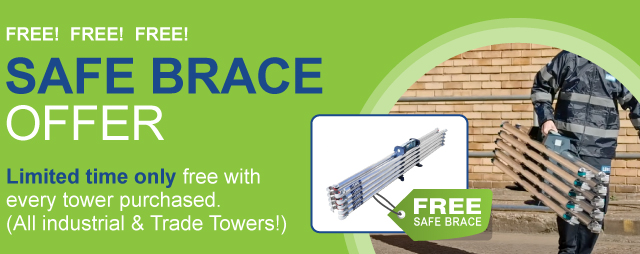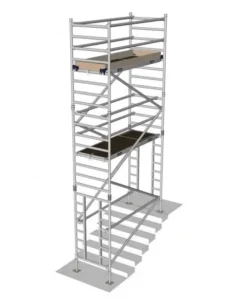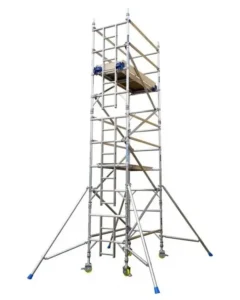If you are working at heights then you will know that nothing is more important than ensuring safety and efficiency. Whether you’re already working in the industry or you’re about to tackle a new DIY project, understanding the proper role of access equipment is crucial. From scaffold towers to ladders and cherry pickers, each piece of equipment has its own unique role in helping you reach elevated areas securely.
That’s why we’ve put together this blog on what is access equipment and how to choose the right one for your project. So whether you’re new to working with heights or looking to enhance safety, we’ll give you everything you need to know about buying the right access equipment!
What Is Access Equipment?
What Is Access Equipment?
Safety is something you shouldn’t overlook when you’re working at height. That’s where access equipment comes into play! But exactly what is access equipment, and why is it so important?
Generally, access equipment refers to any equipment that provides you with a safe and secure way to get to out of reach areas. This includes items like ladders, cherry pickers, and of course, scaffold towers. Whether you’re a construction worker or a DIY enthusiast, having the right access equipment ensures you can work confidently at height.
Types of Access Equipment
When it comes to making sure you choose the right piece of access equipment for the job, you need to understand the different options available as well as their advantages and disadvantages. Although scaffold towers are easily one of the most commonly used, there are several other options available that could even be a better option, depending on the specific job requirements. Here are some of the different access equipments you can choose from:
Scaffold Towers
Safety and stability are both pretty important when choosing access equipment. Scaffold towers are known for providing a stable platform for work at height, and often considered safer than standard ladders especially for jobs that require you to move around whilst at height; such as painting. Whether it’s an indoor or outdoor job, knowing how to erect a scaffold tower will ensure safety when using this equipment.
Combination Ladders
Combination ladders are a versatile option that can have multiple uses, depending on the situation combination ladders can act as straight ladders, step ladders or even as a scaffold base. For those working within a budget, or simply looking for something that can assist with the majority of jobs in the future, a combination ladder can be a great and cost effective option.
You can use combination ladders both indoors and outdoors easily and provide height adjustments at both sides making it a stable and easy to use piece of equipment. So whether you’re painting or gutter cleaning, combination ladders may be your best choice!
Extension Ladders
Designed to extend and retract, extension ladders can reach greater heights compared to standard ladders. These ladders are essential for tasks such as exterior building maintenance, window cleaning or even roof work. One great benefit of extension ladders is that they are able to reach great heights without taking up too much room when stored. Just make sure that you properly secure the top and bottom before use to ensure stability.
Roof Ladders & Step Ladders
Some tasks require light and portable equipment, for those, ladders and step ladders are perfect. Roof ladders are specialised tools designed for safety when accessing pitched roofs. They grip onto the ridge of the roof to prevent slipping which can come in handy when performing roof repairs or inspections. On the other hand, step ladders are commonly used for indoor tasks that require moderate height, such as hanging decorations or reaching high shelves, and their foldable design makes them easy to transport and store.
Telescopic Ladders
If you frequently travel to different job sites, telescopic ladders are well-known and well regarded for their convenience and portability. Since they can collapse down to a compact size when not in use, this makes them ideal for those with limited storage space. Don’t be fooled by their size though, telescopic ladders can extend to impressive heights as well as providing a safe and secure platform whether you’re performing small repair jobs, painting or reaching tall areas of your home.
Mobile Access Towers
Mobile access towers or scaffold towers on wheels, can provide flexible, and elevated work platforms that can be moved as needed. If you need access to multiple areas at height then these towers are ideal! However, knowing how to erect a scaffold tower is crucial to make sure your safety isn’t compromised when using this equipment. Mobile access towers add the benefit of mobility for increased efficiency on the job as the wheels can be locked in place to ensure stability during use.
Podium Steps
For low level jobs that require safety and balance, look no further than podium steps! If you’re working at height for extended periods of time whether you’re installing light fixtures or painting, podium steps offer safety features such as guardrails and non-slip surfaces, making them a safe choice! These are commonly used in warehouses, shops, and other commercial environments over traditional step ladders.
Trestles and Staging
Trestles and staging systems provide an elevated work surface, and are used for painting or plastering large areas. The trestles support planks allowing you to easily create a stable platform to work on or walk across, which offers much more space for movement than a traditional ladder. If you’re working in construction, decorating, or maintenance this equipment is suited for you since you need access to a wider area without constantly repositioning the ladder or scaffold.
Cherry Pickers
If you work in construction, maintenance or even setting up outdoor events, cherry pickers allow you to reach high areas with ease! Cherry pickers are known for being flexible since they can be extended in both vertical and horizontal directions, which allows you to get the job done efficiently. Cherry pickers are ideal for jobs that require quick access and have lots of accessible space like trimming tall trees, changing streetlights, or even cleaning tall buildings. This is because cherry pickers provide a safe and stable working platform, especially for all those hard-to-reach areas.
Boom Lifts
Boom lifts are similar to cherry pickers but are designed to reach even greater heights. Most commonly used in construction, building inspections, and industrial projects, boom lifts are great for when you require access to extremely tall areas. There are different types of boom lifts such as articulated or telescopic, which allow for different levels of flexibility and reach. Like cherry pickers, boom lifts offer a secure and stable platform, but they are better suited for larger industrial jobs that require extended height or reach.
How to Choose The Right Access Equipment
Now that we’ve answered what is access equipment and the different types, it’s important to know how to determine which one is right for you. There are several factors you need to consider before settling on an access equipment, from the type of job you’ll be using it for to the safety measures you need to make sure are in place.
Safety should always be the top priority when working at height, as using the wrong type of access equipment can lead to accidents and even serious injuries. Here are some factors you can consider when choosing the right access equipment:
Project Requirements
Before you choose the right access equipment, you should first take into account the nature of the work. For example, indoor tasks may only require a step ladder or podium steps, but for outdoor work where you need to reach heights, then a scaffold tower may be the best option.
Height
How much height you need to reach is certainly something you need to think about when choosing the right access equipment. Scaffold towers are ideal for working at greater heights, while telescopic ladders offer flexibility for varied height needs.
Safety
When it comes to access equipment, your safety is something you should never overlook. Choose equipment with non-slip surface and guardrails where possible and always ensure you’re in compliance with industry safety measures.
How to Erect a Scaffold Tower
If you’ve decided that a scaffold tower is the right piece of access equipment for you and you’re wondering how to build a scaffold tower, the process is fairly straightforward but requires attention to detail to ensure safety. Here’s how to erect a scaffold tower:
Choose a Solid Ground
Before building a scaffold tower, you need to find a safe location to set up. Always make sure the ground where the scaffold tower will stand is stable and level.
Lay the Base
After you’ve settled on a location it’s time to start assembling the base section, ensuring all frames and braces are securely attached. If your scaffold has wheels, attach them to the base frame at this stage.
Add Height
As you add more sections, use ladders built into the frame to access higher levels. As you build upward, you need to make sure to lock each section into place with the appropriate braces and connectors. Don’t forget to ensure that each level remains square and aligned to avoid instability as the tower gets taller.
Secure the Platform
Once at the desired height, install the working platform, ensuring it is both level and properly locked in place. Also make sure that the platform can support the necessary weight and remains level before use.
Safety Check
Before use, inspect the tower for any loose connections or potential hazards that could compromise your safety. You also need to make sure that all workers or anyone who will be using the scaffold tower know how to safely access and exit the tower and are aware of any weight limits. Safety is the most important part of using any access equipment, so don’t overlook this!
How Long Does It Take To Put Scaffolding Up?
Another common question is: ‘how long does it take to put scaffolding up?’ The time required can vary based on the height and complexity of the tower, but for most standard scaffold towers, it usually takes around 2 hours if you’re familiar with the assembly process. However, larger and more complex scaffolding towers, such as those used on construction sites, can take several hours or even days to fully assemble, depending on the height and the number of platforms required. Proper planning, preparation, as well as attention to detail and safety can help to both streamline building your scaffolding and ensure it is erected securely.
Choose the UK’s Number 1 Scaffold Tower Manufacturer
Now that you know the basics of access equipment you’re probably searching for the best scaffold tower manufacturer for your access equipment needs. We pride ourselves in providing high quality access equipment designed for both professionals and DIY enthusiasts. Whether you’re looking for scaffold towers, ladders, or podium steps, we offer the best equipment for your professional needs that live up to the required safety standards. So what are you waiting for? Contact us today for reliable, safe, and affordable access equipment solutions!





